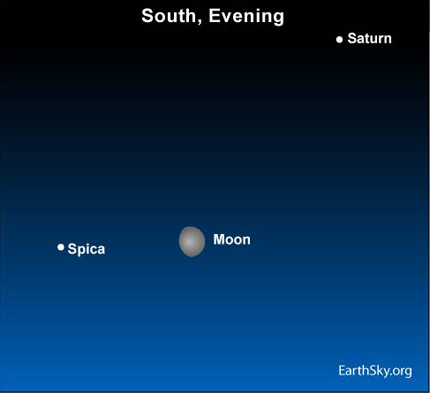Courtesy of EarthSky
A Clear Voice for Science
www.EarthSky.org

 Yesterday – on Saturday evening – the waxing gibbous moon shone close to the planet Saturn. This Sunday evening, a fuller waxing gibbous moon beams in between Saturn and the star Spica. Tomorrow – on Monday – a larger yet waxing gibbous moon will couple up with Spica, the brightest star in the constellation Virgo.
Yesterday – on Saturday evening – the waxing gibbous moon shone close to the planet Saturn. This Sunday evening, a fuller waxing gibbous moon beams in between Saturn and the star Spica. Tomorrow – on Monday – a larger yet waxing gibbous moon will couple up with Spica, the brightest star in the constellation Virgo.
As the moon makes its rounds through the starry heavens, its passes through every constellation of the Zodiac and by each solar system planet during the course of one sidereal month. The sidereal month refers to the moon’s full-circle journey in front of the background stars: a period of 27.3 days. The sidereal month represents the true measure of the moon’s orbital period around Earth.
Next month, the moon will pair up with Saturn on June 18 and Spica on June 20. However, will the phases be the same when the moon meets up with Saturn and Spica in June?
No, the phases will be smaller next month. That is because the lunar month – the month as measured by the cycle of the moon’s phases – lasts some 29.5 days. The lunar (or synodic) month is 2 days longer than the sidereal month: the moon’s full-circle trip through the stars.
Written by Bruce McClure
Astronomy Picture of the Day from NASA/JPL
U.S. Naval Observator Astronomical Information center
The York County Astronomical Society